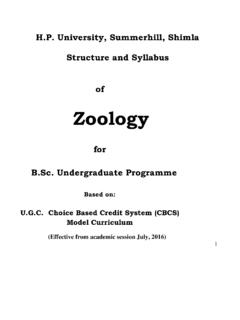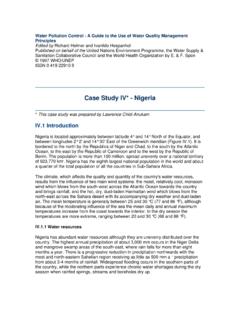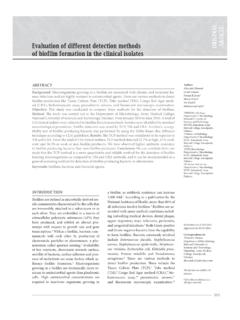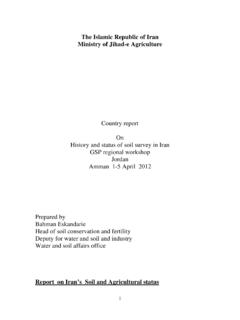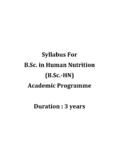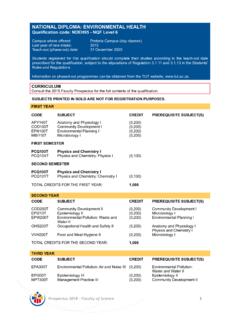Transcription of M.Sc. Botany Semester I MARKS: 400 I BIOLOGY AND …
1 1 Botany Semester I MARKS: 400 Course No. Title of Course Marks I BIOLOGY AND DIVERSITY OF ALGAE AND FUNGI 60 II BIOLOGY AND DIVERSITY OF MICROBES AND PLANT PATHOGENS 60 III BIOLOGY AND DIVERSITY OF BRYOPHYTES AND PTERIDOPHYTES 60 IV PLANT RESOURCE UTILIZATION AND BREEDING 60 PRACTICAL I-IV (20 MARKS Each) 80 INTERNAL ASSESSMENT (15 Marks Each) 60 ATTENDANCE (5 Marks Each) 20 TOTAL 400 Semester II MARKS: 400 Course No. Title of Course Marks V CELL AND MOLECULAR BIOLOGY (COMMON COURSE) 60 VI BIOSTATISTICS & COMPUTER AOOLICATIONS (COMMON COURSE) 60 VII BIOLOGY AND DIVERSITY OF GYMNOSPERMS 60 VIII BIOLOGY AND DIVERSITY OF ANGIOSPERMS I 60 PRACTICAL V-VII (20 MARKS EACH) 80 INTERNAL ASSESSMENT (15 MARKS EACH) 60 ATTENDANCE (5 MARKS EACH) 20 TOTAL 400 Semester III MARKS: 400 Course No.
2 Title of Course Marks IX CYTOGENETICS AND EVOLUTION (COMMON COURSE) 60 X IMMUNOLOGY AND BIOTECHNOLOGY (COMMON COURSE) 60 XI BIOLOGY AND DIVERSITY OF ANGIOSPERMS II 60 XII PLANT PHYSIOLOGY 60 PRACTICAL IV-XII (20 MARKS EACH) 80 INTERNAL ASSESSMENT (15 MARKS EACH) 60 ATTENDANCE (5 MARKS EACH) 20 TOTAL 400 Semester IV MARKS: 300 Course No. Title of Course Marks XIII BIOCHEMISTRY (COMMON COURSE) 60 XIV ECOLOGY (COMMON COURSE) 60 XV SPECIAL PAPER 60 PRACTICAL XIII-XV (20 MARKS EACH) 60 INTERNAL ASSESSMENT (15 MARKS EACH) 45 ATTENDANCE (5 MARKS EACH) 15 TOTAL 300 Grand Total: 1500 2 Special Paper: 1.
3 Advanced Topics in Mycology 2. Advanced Topics in applied microbiology 3. Advanced Topics in Plant Pathology 4. Wood Sciences, Forest Biodiversity and Plant Resources 5. Biodiversity, Bioprospecting, Ethnobotany and Sustainable Utilization of Plant Resources 6. Plant Reproduction, Tissue Culture and Horticultural Sciences 7. Advanced Palnt Physiology and Biochemistry. 3 Semester I Course I: - BIOLOGY AND DIVEERSITY OF ALAGAE AND FUNGI Algae: 1. Algae in diversified habitats (terrestrial, fresh water, marine) 2. Thallus organization in algae 3. Cell ultra-structure 4. Reproduction (Vegetative, asexual, sexual) and patterns of life cycle.
4 5. Criteria for classification of algae (pigments, reserved food, flagella). 6. Fine structure of algal plastids. 7. Algal 8. Algal biofertilizres 9. Economic importance of algae 10. General account of lichens and their economic importance Suggested Reading: Fritsch, F. E. The structure and reproduction of algae. Vol. I & II, London, Cambridge Univ. Press (1971-72) Kamat, N. D. (1982), Topics in algae, Sai Kirpa Prakashan, Aurangabad. Kumar, H. D. (1988). Introductory Phycology. Affiliated East-West Press limited, New Delhi. Round, F. E (1986). The BIOLOGY of algae. Cambridge University Press, Cambridge. Kumar, H. (1985). Algal cell BIOLOGY .
5 Affiliated East-West Pres Limited, New Delhi. Moris. I. (1967). An Introduction to the Algae. Hutchinsen University Library, London. Fungi: i) Introduction to Mycology: General characteristics of fungi, their significance to human, organization of fungal cell, thallus and modifications thereof; ultrastructure, reproduction (vegetative, asexual, sexual), recent trends in classification. ii) Comparative study of habit, habitat, somatic organization, anamorphs, teleomorphs and evolutionary tendencies ,in any of these phases in the life cycle of the members of Dictyosteliomycota and Myxomycota (Dictyostelium, physarum) Chytridiomycota and Oomycota (olpidium, synchytrium, Allomyces, Plasmodiophora, Saprolegnia, Pythium, Pyytophora and Downy mildews), Zygomycota (within members of Zygomycetes)
6 , Ascomycota (Ascocarp development, ascocarp types, centrum types and their bearing on classification, with emphasis on Protomyces, Taphrina, Yeast, Penicillum, Aspergillus, Chaetomium, Neurospora, Claviceps and Venturia; and general account of powdery mildews and Discomycetes, Basidiomycota, (basidiocarp types, development, general account of Hymenomycetes, Ustilaginomycetes and urediniomycetes, Alternaria, Helminthosporium, Cercospora, Colletotrichum, Pyricularia, Fusarium 4 iii) Sex hormones in fungi, Heterothallisum and parasexual cycle in fungi, nutrition in fungi (saprophytes, parasites, predators, symbionts).)
7 I iv) mportance oof Fungi in different microbiological and Biotechnological processes fungi min food and food industry , as agents of biodeteriooration and biodegradation, in agricturue, in medical biotechnology and as agents of biotransformation, biosorption and biomining. Suggested Books : 1. Ainsworth, G. C., Sparrow, F. K. And Man, A. F. S. The fungi- an advanced treatise Academic Press, 1973. 2. Alexopoulos, C. J. and Mims, C. W. Introductory mycology, 3rd Edition , Wiley- Easter, New Delhi 3. Alexopoulos, C. J. and Mims, C, W. and Blackwell, M, Introductriy mycology. John Wiley and Sons. 1996 4. Deacon, J.
8 W. Introction to Modern Mycology ELBS. 5. Moore- Landerckar, E. J. 1972. Fundamentals of the fungi. Prentice hall, Englewood Cliffs. 6. Burnett, H. L. Fundamentals of Mycology . Edwand Arnold, London. 7. Aneja Krand Mehrotra R. S. Introductory Mycology. 8. Dube, R. and Mukerji, K. G. 2001. Microbial Technology A. P. H. > Publishing corporation, New Delhi. 9. Gupta, R and Mukerji, K. G. 2001 Microbial Technology A. P. H. Publishing Coprporation, New delhi. Course II: BIOLOPGY AND DIVERSITYT OF MICROBES AND PLANT PATHOGEN 1. History of plant pathogens, concept, diagnoses, classification, importance and identification of unknown diseases; symptomology and disease development.
9 2. Host- pathogen interaction at plant and cellular level: Mechanism of pathogen attack and defense: Physical, Physiological, biochemical and molecular aspects. 3. Host-pathogen- interaction at population level: Transmission and spread of plant pathogens, disease epidemics,, modeling and disease forecasting to control crop losses. 4. Management of plant disease: Chemical, Biological, IPM system, development of transgenics, biopesticides, plant diseases clinics, quarantine. 5. Genetics of plant disease: Gene for virulence and avirulence. Their application in resistance and susceptibility, induced resistance (immunization) 6.
10 Specific plant disease caused by diverse pathogens: Black wart disease of potato, Club root of crucifers, damping of seedlings, late blight of potato, downy mildew of grapes an bajra, stem gall of coriander, peach leaf curl, powdery mildew of wheat and apple, apple scab, general account of rusts, smut and bunts, Fusarial wilt of tomato, rhizome rot of ginger, tikka disease of groundnut, red rot of sugarcane, brown leaf spot and blast of rice. Bacterial blight bean, common scab of potato, fire blight of apple, citrus canker, potato leaf roll, potato spindle tuber, tobacco mosaic virus.

